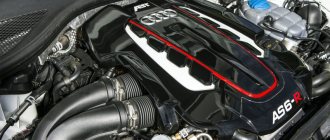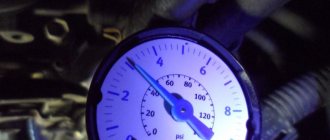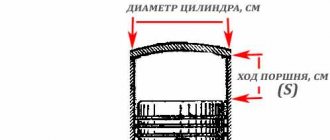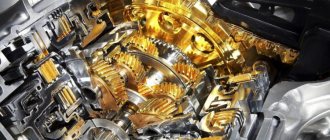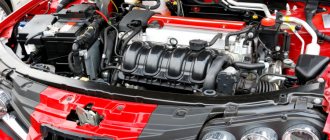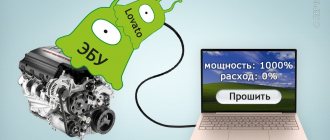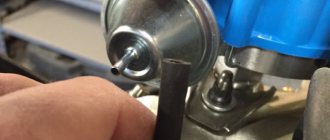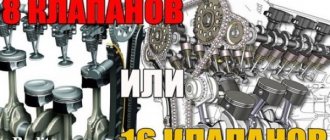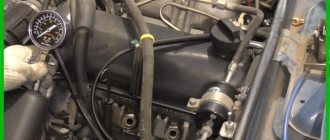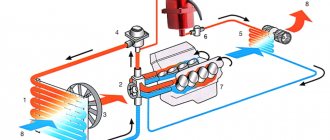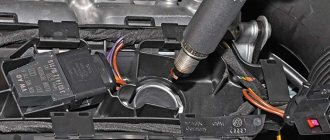Published: 01/28/2021
- How does a four stroke engine work?
- Comments
- Two-stroke engine - operating features
- What are the main differences?
- Warnings
- Types of motors
- Operating procedure
- Two-stroke engines
- Stroke cycles in diesel internal combustion engines
- Expanded classification of thermometers
- Carburetor and injection engines.
- Operation - Duty Cycle
- Torque and horsepower
- Design features
- Origin information
- 7.4. Pedagogical assessment as a means of influence
- Where is it used?
- Bottom line
How does a four stroke engine work?
Structurally, the working cycle of a typical four-stroke unit is ensured by the operation of the following elements:
- cylinder;
- piston - performs reciprocating movements inside the cylinder;
- intake valve – controls the process of supplying the air-fuel mixture to the combustion chamber;
- exhaust valve – controls the process of exhaust gases expelling from the cylinder;
- – ignites the resulting air-fuel mixture;
- crankshaft;
- camshaft - controls the opening and closing of valves;
- belt or chain drive;
- crank mechanism - translates the movement of the piston into rotation of the crankshaft.
Duty cycle of a four-stroke engine
The working cycle of such a mechanism consists of four cycles, during which the following processes are implemented:
- Intake (fuel and air injection). At the beginning of the cycle, the piston is at TDC. At the moment when the crankshaft begins to rotate, it acts on the piston and moves it to BDC. This leads to the formation of vacuum in the cylinder chamber. The camshaft acts on the intake valve, gradually opening it. When the piston is in its extreme position, the valve is completely open, resulting in intense injection of fuel and air into the cylinder chamber.
- Compression (increasing the pressure of the combustible mixture). In the second stage, the piston begins to move back to the top dead center of the compression stroke. The crankshaft makes another turn and both valves are completely closed. The internal pressure increases to 1.8 MPa and the temperature of the combustible mixture rises to 600 C°.
- Expansion (working stroke). When the piston reaches the top position in the combustion chamber, the maximum compression is set to 5 MPa and the spark plug is fired. This leads to combustion of the mixture and an increase in temperature to 2500 C°. Pressure and temperature lead to an intense impact on the piston, and it begins to move back to BDC. The crankshaft makes another turn, and thus the thermal energy is converted into useful work. The camshaft opens the exhaust valve, and when the piston reaches BDC, it is fully open. As a result, the exhaust gases begin to gradually leave the chamber, and the pressure and temperature decrease.
- Exhaust (removal of exhaust gases). The engine crankshaft turns and the piston begins to move to the top point. This leads to the expulsion of exhaust gases and an even greater decrease in temperature and a decrease in pressure to 0.1 MPa. Next, a new cycle begins, during which these processes are repeated again.
The four-stroke engine has become widespread. It can work with both gasoline and diesel fuel. The difference between the operating cycle for a diesel engine is that the ignition of the air-fuel mixture does not occur from a spark, but from high pressure and temperature at the end point of the compression stroke.
Engine types
The engine has the following main types:
1) By engine location
Heat or heat engines
The heat engine includes known types. In a general sense, these motors require a base heater to operate. Depending on the method of heat production, they can be continuous (not connected) or unconnected.
They work by directly burning fuel or changing fluid to create work. As a result, most heat engines find some kind of superior chemical propulsion technology.
Internal combustion engines (ICE).
It is one of the most common types of engines. In this type, the combustion process takes place inside the engine.
They are used in trucks, lawn mowers, helicopters, etc. The largest IC engine can produce up to 109,000 horsepower to move a vessel that can hold 20,000 containers. They receive energy from the combustion of fuel in a special area of the system called the combustion chamber.
This type of engine contains a piston, combustion chamber, compression chamber, fuel pump/fuel injector and spark plug. They are capable of using different types of fuel such as gasoline, diesel and gas.
External combustion engines
An external combustion engine (ICE) is one of the well-known types of engines. In these engines, the combustion process occurs outside the engine. The fuel is stored in a separate cylinder. In some cases, EC works similarly to IC, but both require heat from burning fuel.
In this engine, when fuel burns, thermal energy is released. This generated heat is used to heat water and turn it into steam. This high pressure steam acts on the piston, which begins to move up and down inside the compression cylinder. The movement of the piston rotates the crankshaft, which then rotates the turbine, car wheels or any other unit.
Most types of such engines run on steam. The Stirling engine is an example of an EPS that runs on steam.
Electric motors
Electric motors use three types of electromagnetism: magnetic, piezoelectric, and electrostatic. Magnetic, like battery-powered, is the most widely used. It relies on the interaction of magnetic fields and electric current to produce a function.
It works on the same principle as the dynamo used to produce electricity, but in a different way. Of course, you can generate electricity if you run the generator manually.
2) Types by engine design
Piston engine
The piston engine is the most common type of engine. It is also known as a reciprocating or "piston" engine. It uses a piston to compress the air-fuel mixture. The piston reciprocates up and down inside the compression chamber.
The up and down movement of the piston helps convert the fuel's energy into mechanical work. When the piston compresses the air-fuel mixture, the temperature and pressure of the mixture become very high and it ignites. The resulting energy is used to move the car.
These engines can use a variety of fuels such as methane, propane, gasoline, natural gas and diesel. They are used in many residential, marine, space and industrial applications such as motorcycles, automobiles, ships, buses, peak loads and railways.
One of the main disadvantages of a piston engine is that it has lower thermal efficiency than a Wankel engine.
Advantages and disadvantages of a piston engine:
| Advantages | Flaws |
| They have the ability to start and stop very quickly. | They produce very high emissions. |
| They require a very short time to initially start up. | The cost of maintaining these engines is very high. |
| They have a lower cost than jet engines. | They generate low-grade heat. |
| They have moving pistons inside a compression chamber. | These motors have lower thermal efficiency compared to rotary motors. |
Rotary engine
A rotary engine uses a rotor instead of a piston. None of its parts have a reciprocating motion. It is also known as a Wankel rotary engine. The rotor rotates inside the compression chamber. This rotor compresses the air-fuel mixture and produces energy. The resulting power is used to move the car. It has very high thermal efficiency.
The parts of these engines move at low speed. Therefore they are more reliable. They also have fewer moving components than piston engines.
They are used in a variety of applications such as auxiliary power units, chainsaws, snowmobiles, jet skis, go-karts, aircraft, race cars, motorcycles and automobiles.
The main disadvantages of these engines are that they have high emissions, produce less power and consume more fuel. However, they are light and small in size.
Advantages and disadvantages of rotary engines:
| Advantages | Flaws |
| It has a simple design. | They have leakage problems that reduce their effectiveness. |
| This type of engine has lower parts than a piston engine. | They have a low life cycle. |
| Has high thermal efficiency. | It needs high maintenance. |
| Has low noise and vibration levels during operation. | They have high emissivity. |
3) Types of engines depending on the fuel used
Gas engine
These engines use gasoline as the working fluid. A gasoline engine uses a mixture of air and gasoline to generate energy. Gasoline is also a mixture of carbon and hydrogen.
This type of engine has a piston that moves up and down to suck in and compress fuel. First, air enters the carburetor and the fuel injector injects gasoline into the carburetor. The carburetor produces a mixture of air and gasoline and directs it into the combustion chamber.
When the air-gasoline mixture enters the combustion chamber, the piston compresses it to very high temperatures and pressures. But this temperature is not enough for the air-gasoline mixture to ignite on its own. Therefore, a spark plug is used to ignite the compressed air-gasoline mixture. This spark plug is installed at the top of the combustion chamber.
At the end of the compression stroke, the spark plug supplies a spark to the mixture and ignites it. The power generated is used to drive a vehicle or other equipment.
These engines rotate faster than diesel engines because they have lightweight camshafts, connecting rods, pistons and crankshafts.
The piston stroke of a gasoline engine ends faster than that of a diesel engine. They are less efficient because they have a lower compression ratio.
They are used in many applications such as powerboats, aircraft, motorcycles, chainsaws, portable generators and lawn mowers.
Advantages and disadvantages of gasoline engines:
| Advantages | Flaws |
| They have more horsepower than diesel. | Has a low compression ratio. |
| Gasoline fuel has a lower cost than diesel fuel. | Gasoline fuel burns faster than diesel fuel. |
| It has low maintenance cost. | They have a shorter life cycle than diesel engines. |
| It has lower emissions than diesel. | They have lower efficiency. |
Diesel engine
A diesel engine uses diesel fuel as its working fluid. They are less powerful in terms of horsepower than gasoline ones. Diesel is a light fuel. This fuel has a high cetane number, higher compression ratio and lower viscosity. In this engine, air and diesel are not compressed at the same time.
Air first enters the compression cylinder during the suction stroke. During the compression stroke, air is compressed by the piston moving up and down. As a result of compression, the air becomes compressed air with a very high temperature.
At the end of the compression stroke, the fuel pump injects diesel fuel into the compression chamber, where it mixes with air. When diesel comes into contact with compressed air, it ignites and produces energy.
A spark plug or any other external ignition source is not required as the air-diesel mixture ignites on its own due to the high air temperature. The final power output is used to operate various types of machines.
Gasoline burns faster compared to diesel fuel. They have very high efficiency because they have a high compression ratio. They are used in buses, industrial equipment, motorcycles, ships and aircraft.
Advantages and disadvantages of a diesel engine:
| Advantages | Flaws |
| They have high thermal efficiency. | They are less powerful in terms of horsepower. |
| They have a high compression ratio. | They are expensive. |
| They have excellent fuel economy. | Diesel fuel is expensive. |
| They are more reliable. | They require additional maintenance costs. |
| They are best suited for heavy vehicles and industrial applications. | They have a complex design. |
Gas engine
A gas engine uses gas as a working fuel. These types of motors are used in heavy industrial equipment these days as they are capable of running continuously for long periods of time. They use oil, kerosene or gasoline. The gas turbine consists of two sections:
- Gasifier Section: In this section the gas is burned and then the resulting gas enters the power section.
- Power Section: This section receives power from the gasifier section and rotates the wheels of the vehicles using the power steering system.
The gasifier has a compressor with several blades along the edge of the rotor. When the rotor begins to rotate, centrifugal force occurs, which removes air from the space between the blades and introduces it into the combustion chamber. As a result, the air pressure in the combustion chamber increases.
The fuel pump injects fuel into the combustion chamber and burns it, which further increases the pressure. The final power output is used to operate the vehicle.
Advantages and disadvantages of a gas engine:
| Advantages | Flaws |
| Has low repair costs. | They have a short service life. |
| It has low maintenance cost. | They have low thermal efficiency. |
| This type of engine is characterized by low rigidity, vibration and noise. | They have problems with detonation. |
| They are light weight and small in size. | They have a lower resale value. |
Jet engine
A jet engine uses the thrust produced by jet thrust to propel an airplane forward and helps it fly fast.
These types of engines are also known as gas turbines or gas engines. A jet engine consists of a compressor, a fan, a turbine and a nozzle.
First, the fan sucks air from the atmosphere and sends it to the compressor. The compressor increases the pressure and temperature of the air as per the requirement and sends the compressed air into the combustion chamber.
The fuel pump is located at the top of the combustion chamber. This pump injects fuel into the chamber and mixes it with air. Due to high air compression, when fuel comes into contact with air, the air-fuel mixture ignites and hot gases are generated.
When hot gases strike the turbine blades, the blades extract the thermal energy of the hot gases and convert it into mechanical energy. Part of this energy is used to operate the compressor, and the rest is directed to the nozzle.
The nozzle converts the received energy into high speed and creates thrust, which helps the aircraft move forward. Turboprop and turbofan engines are examples of jet engines.
4) Types depending on the duty cycle
Otto cycle engine
Various types of engines use the Otto cycle. The Otto cycle is most widely used in gasoline engines. In 1876, German scientist Nicholas August Otto invented the Otto cycle. Therefore, it is known as the "Otto cycle" due to the name of its inventor.
This cycle completes the power cycle in four steps (i.e., two isentropic and two isochoric processes). The diagram below represents the Otto cycle.
Otto cycle engines have a crankshaft, camshaft, piston and connecting rod. The piston is used to compress the air-fuel mixture, and the camshaft is used to control the opening and closing of the intake and exhaust valves at the desired times.
The Otto cycle works in the following four stages:
- Adiabatic compression
- Isochoric compression
- Adiabatic expansion
- Isochoric expansion
Diesel cycle engine
The cycle in which diesel fuel is burned and energy is generated through the combustion process of diesel fuel is known as the Diesel cycle. In 1897, Dr. Rudolf Diesel invented the Diesel cycle. A diesel engine operates on this cycle.
The Diesel cycle is also known as the constant pressure cycle. This is because in this cycle the air is compressed at a constant pressure.
There is no need to compress air and diesel fuel as in the Otto cycle. It also completes the power cycle in the following four steps:
- Adiabatic compression
- Adding heat at constant pressure
- Isentropic expansion
- Heat removal at constant volume.
In this cycle, firstly, air enters the compression cylinder from the environment. This cylinder has a piston that reciprocates from TDC (upper) to BDC (lower) and vice versa. As air enters, the piston moves upward and adiabatically compresses the air. Lines 1 - 2 of the above diagram represent this process.
When the air is compressed as required, the fuel pump injects diesel fuel, which is mixed with the compressed air. The mixture of air and diesel fuel ignites due to the very high temperature of the compressed air (line 2 - 3 represents this process). During this process, heat is added at constant pressure.
After the process of adding heat, the process of isentropic expansion begins (line 3-4). In this process, the air-diesel mixture expands in the cylinder.
The heat from the air-diesel mixture does work on the piston and causes it to move downward. As the piston rotates, it rotates the crankshaft, which then rotates the wheels of the car and sets it in motion.
Double cycle engines
The dual combustion cycle is the combustion of the diesel cycle and the Otto cycle. Russian-German engineer Gustav Trinkler introduced the double combined cycle.
An engine operating on both the Otto cycle and the diesel cycle is called a dual-cycle engine. These types of engines take longer to burn fuel. However, they are smaller and quieter than diesel engines. They also require a small footprint compared to diesel engines.
This cycle also completes the power cycle in four stages (i.e. two isochoric and two adiabatic). The Stirling engine is an example of a double cycle engine.
The following processes occur in this cycle:
- Isothermal compression
- Isochoric heat addition
- Isothermal expansion
- Isochoric heat removal
5) Types by number of clock cycles
Four stroke engine
In a four-stroke engine, the power stroke is completed after two revolutions of the crankshaft or four strokes of the piston (i.e. suction, compression, expansion and exhaust). These engines are available in petrol and diesel.
One of the main advantages of 4-stroke engines is that they are environmentally friendly and emit fewer harmful gases. They have high durability and reliability compared to two-stroke ones. However, they have a complex design and generate low power compared to two-strokes.
Four-stroke engines are used in many applications such as trains, trucks, buses, scooters and cars.
Advantages and disadvantages of four-stroke engines:
| Advantages | Flaws |
| They have high fuel efficiency. | They have less power. |
| They have a lower operating noise level compared to two-stroke engines. | They have more details. |
| A four-stroke engine has a longer service life than a two-stroke engine. | It has a complex design. |
| They have high wear resistance. | It is more expensive than 2-stroke. |
Two stroke engine
This engine completes its power stroke after one revolution of the crankshaft or two strokes of the piston. Simply put, when the crankshaft makes one stroke, the stroke of the piston is completed and power is produced, which is used to propel the vehicle.
In this engine, the intake and compression strokes are completed in one stroke, and the expansion and exhaust strokes are completed in a second stroke. Thus, this engine completes its power stroke in just two piston strokes. It also takes less time to complete the stroke of the piston than a 4-stroke.
They generate more power than four-stroke engines. They are used in buses, trucks and cars. One of the main advantages of two-stroke engines is that they are small in size and require little installation space. However, they produce more noise and toxic gases compared to four-stroke engines.
Advantages and disadvantages of two-stroke engines:
| Advantages | Flaws |
| They are small in size. | It is not environmentally friendly. |
| They generate more energy. | Has low volumetric efficiency. |
| They have low cost. | They have low efficiency. |
| They are light in weight. | High emission level. |
Six stroke engine
It is one of the most common types of engines. A six-stroke engine completes its power cycle with six piston strokes. As a result, the crankshaft rotates three times during fuel combustion.
6) Types of engines depending on the ignition process
Spark ignition (SI) engine
An engine that uses a spark plug to combust the air-fuel mixture is known as a spark ignition (SI) engine. It is also known as a gasoline engine.
The spark plug is located at the top of the combustion chamber. SI engines have a spark plug, piston, combustion chamber and crankshaft. When the air-gasoline mixture enters the combustion chamber, the piston compresses the air-gasoline mixture to very high temperatures and pressures.
When the air-gasoline mixture is compressed as required, the spark plug produces a spark and ignites the mixture. This ignition process produces heat, which is used to propel the vehicle.
Compression ignition engines (ICE)
In a CI engine, the air-fuel mixture is ignited by high air compression. Diesel fuel is used as working fuel. The combustion process does not require a spark plug.
These types of engines have a higher compression ratio than SI engines. They have a fuel pump, crankshaft, piston and compression cylinder. When air enters the compression cylinder, the piston compresses it strongly.
At the end of the compression stroke, the fuel pump injects diesel fuel into the compression cylinder. When diesel fuel comes into contact with compressed air, it ignites and generates heat, which is used to propel the vehicle.
One of the main advantages is that they generate more power and are best suited for heavy vehicles.
7) Types by number of cylinders
Single cylinder engines
A single-cylinder engine uses only one cylinder to compress the air-fuel mixture.
They are typically used for light vehicles such as motorcycles and scooters. The single-cylinder engine capacity ranges from 250 to 300 cc. cm.
These engines produce one stroke of power after two revolutions of the crankshaft. Thus, three strokes of the piston are used to destroy the frictional resistance of the moving parts, and the power of the remaining one stroke is used to propel the vehicle. Uneven torque distribution within the cycle results in vibration and rough operation.
This engine also has only one connecting rod and one piston, which rotates with the stationary components to balance their weight. These types of engines also do not have mechanical balance. However, by using a counterweight linked to the crankshaft and a very heavy flywheel, the engine is intelligently balanced and its momentum produces a relatively stable motion.
One of the main advantages of a single cylinder engine is that it is lightweight and small in size. It can be easily carried from place to place, but is not suitable for heavy vehicles.
Twin cylinder engine
A twin-cylinder engine uses two cylinders to compress air. They are most often used in tractors. They are also used in Dutch DAF cars and small German cars.
They are heavy and large in size. However, they have a higher compression ratio compared to single-cylinder engines.
These types of engines have the following three main types:
- opposed type
- V-shaped
- Inline vertical type
Three-cylinder engines
These types of engines have three cylinders. These three cylinders are installed in a row. The three-cylinder engine is used in front-wheel drive vehicles in which the differential is mounted between the transmission and the engine.
This is a type of two-stroke engine. This means that these engines complete their power stroke after two strokes of the piston. The crankcase acts as a suction and pre-compression cylinder. All cylinders have their own sealed crankcase section.
Four-cylinder engines
Four-cylinder engines are mainly used in conventional cars. These types of engines provide more consistent torque than twin-cylinder engines.
They are more efficient than two-cylinder and three-cylinder types. However, they have more moving parts and weight than three-cylinder engines.
Six and eight cylinder engines
These types of engines provide more power and smoother torque. The cylinders of these engines are arranged as follows:
- Row
- opposed type
- V-shaped
Inline 6-cylinder and V8 engines are used throughout the world in a variety of vehicles. V8 engines have a 90° angle between the cylinder banks.
V8 engines with a smaller V-angle have also appeared on the market, but their valves have a complex operating mechanism.
The V-6 engine contains two banks of three cylinders positioned at an angle to each other. However, the crankshaft contains three cranks, and the connecting rods of the two opposing banks of cylinders are connected by a single connecting rod pin. Two connecting rods are connected to one connecting rod.
Twelve-cylinder and sixteen-cylinder engines
The cylinders of twelve-cylinder and sixteen-cylinder engines have the following arrangement:
- Type X has 4 rows of cylinders.
- The pancake or V-type has two rows of cylinders.
- Type W has 3 rows of cylinders.
Passenger cars, industrial equipment, trucks and buses use 12- and 16-cylinder engines. Ferrari is the only passenger car currently produced with a 12-cylinder engine.
 Engine types Cylinder arrangement
Engine types Cylinder arrangement
According to the arrangement of the cylinders, the engines have the following types:
Vertical motors
The cylinders of a vertical engine are installed in a vertical position. Therefore, the pistons also move vertically up and down inside the cylinders, as shown in the diagram below. They are light weight and simple in design.
Horizontal motors
The cylinders of a horizontal engine are installed in a horizontal position. Therefore, the pistons also move horizontally up and down inside the cylinders, as shown in the diagram below.
Radial engine
This is a type of internal combustion engine. In these types of engines, the cylinders extend from a central crankcase like the spokes of a wheel. From the front, this type of engine looks like a stylized star. Therefore it is also known as a star engine.
They were used in aircraft before the development and popularity of gas turbine engines. In a radial engine, the cylinders are mounted in a circle around the crankcase as shown in the figure below. This arrangement of the cylinders provides more efficient cooling.
V-type engine
In a V-twin engine, the cylinders are arranged at a fixed angle in two rows or banks. These two rows have as little angle as possible to avoid vibration and balancing problems.
W type motor
In these types, the cylinders are installed in such a way that they form a W-shape arrangement. All these cylinders are installed in three banks.
Opposed engine
In these engines, the cylinders are installed opposite each other. Connecting rods and pistons make the same movement. These types work more smoothly as compared to other types. They have excellent balance. However, they are large in size due to the opposite arrangement of the cylinders.
9) Types of engines depending on the location of the valves
L-head engine
In this L-shaped engine, the exhaust and intake valves are located side by side and their operation is controlled by a single camshaft. The cylinders and combustion chambers are shaped like an inverted L. With the exception of the L-head V8 engine, all other engine valves are mounted in a single row.
In L-head engines, the valve trains are mounted inside the cylinder block, allowing the cylinder head to be easily removed when the engine needs to be serviced. These engines are very durable and reliable, but are not very suitable for high compression applications.
Engines with I-shaped cylinder head
I-head engines have exhaust and intake valves mounted in the cylinder head. With this arrangement, one valve controls all the other valves. I-head engines are most commonly used in automobiles.
In the case of an in-line engine, the valves are installed in only one row. However, in a V8 engine, the valves can be installed in one or two rows per bank. The camshaft drives all valves, regardless of their location.
I-head engines are best suited for high compression ratios. They can significantly reduce backlash compared to L-head motors.
F-head engine
This type is a combination of L-head and I-head engines. The exhaust valve is installed in the block, and the intake valve is installed in the cylinder head. A single camshaft controls the operation of these valves.
T-head motors
In these types, the exhaust valve is installed at one end and the intake valve at the other. However, two camshafts are used to control these valves (i.e. one camshaft per valve).
10) Types depending on the engine cooling process
Air-cooled engines
This type uses air to cool the engine. These types of motors use metal fins to provide a heat dissipation surface, which increases the cooling process.
Maximum types of air-cooled engines have metal covers that direct airflow to the cylinder to improve cooling. However, they do not use water for cooling, eliminating maintenance concerns in cold weather. They are used for scooters and motorcycles.
Water cooled engines
This type uses water to cool the engine. They are used in cranes, buses, trucks, cars, cars and other four-wheelers and large vehicles. In cold weather, antifreeze is added to the water to stop it from freezing.
Engine Applications
- Used in passenger cars.
- Used in trucks.
- They are also used in aircraft.
- Used on trains.
- It is used in almost all road vehicles such as buses, motorcycles, scooters, etc.
- Engines are used in hydroelectric power plants.
- It is connected to a turbine to generate electricity.
- Used in almost all industries for various purposes.
- They are also used in small machines such as generators.
- Used with a water pump
Two-stroke engine - operating features
If we consider a two-stroke engine, it should be noted that gas fuel exchange occurs when the piston is near the lower limit point (dead point), somewhat short of reaching it. Exhaust gases begin to be removed from the cylinder when their volume changes over a short period of time. Cleaning the cylinder in a classic two-stroke engine is done by blowing air through the compressor.
During purging, the air is partially removed and the exhaust gases are released using exhaust ports before they are closed by the piston. After this, the compression process begins, proceeding as in a conventional four-stroke engine. When the piston moves from bottom to top, the purge windows are blocked, after which air from the compressor is no longer supplied to the cylinder.
Internal combustion engine structure
Heat engines of this type operate on liquid and gaseous fuels. This fuel can be oil, gasoline, kerosene, and various flammable gases.
Figure 1 shows a cross-sectional diagram of a simple internal combustion engine.
Figure 1. Design of an internal combustion engine
The engine is a durable metal cylinder. Inside this cylinder there is a movable piston 3 . The piston is connected by connecting rod 4 to the crankshaft 5 .
At the top of the engine there are two valves 1 and 2 . When the engine is running, they automatically open and close at certain desired moments.
Through valve 1 , a combustible mixture enters the engine cylinder. It is ignited using a candle 6 .
A combustible mixture is a mixture of flammable gases, liquid fuel particles and fuel vapors with air (oxygen).
Exhaust gases are released through the valve 2.
Periodically, combustion of the combustible mixture occurs in the cylinder. For example, a mixture of gasoline vapor and air burns. Combustion gases are formed. Their temperature reaches high values - $1600-1800 \degree C$. As a result, the pressure on the piston increases sharply.
These gases (combustion products) push the piston. When the piston moves, the crankshaft also moves. Thus, gases perform mechanical work. That is, part of the internal energy of gases turned into mechanical energy. Consequently, the internal energy of the gases has decreased - they begin to cool .
What are the main differences?
Features of operation require consideration first in order for the comparison to be correct:
- In diesel engines, the air-fuel mixture is formed much faster when compared to a unit running on gasoline. In the cylinders of such engines, only air is compressed, the temperature of which corresponds to approximately 900 degrees. Gasoline is supplied separately to the compartment for subsequent combustion. Small fragments of diesel fuel evaporate at an accelerated rate and combine with the air mass. Due to the sufficiently high temperature effect, the resulting mixture is easily ignited without the need for ignition with a spark. Such engines consume significantly less oil.
- Air and fuel in gasoline engines are combined in a specially designed exhaust manifold, after which the fuel enters the compartment for further combustion. When the compression stroke is completed, the final stage of formation of the fuel-air composition is completed and its subsequent distribution throughout all compartments of the cylinder. After squeezing, the resulting mixture reaches a temperature of approximately 500 degrees, and then the procedure of igniting it using a candle is performed.
Types of motors
There are three types of engines found in vehicles:
- piston
- rotary piston
- gas turbine
The first version of motors is very popular. Some car models are equipped with four-stroke piston engines. This popularity is due to the fact that such units are cheaper, light in weight and suitable for use in almost all machines, regardless of production.
In simple terms, a car engine is a special mechanism that can change heat energy, turning it into mechanical energy, which makes it possible to ensure the operation of many structural elements of the car, as well as its systems.
It is not difficult to study the principle of operation of the motor. For example, piston internal combustion engines are divided into two- and four-stroke units. Four-stroke engines are called because in one operating cycle of the element the piston moves four times (stroke). More information about what bars are is written below.
What is an engine?
An engine is a mechanical machine that converts fuel energy into mechanical energy and propels a vehicle. In thermodynamics, an engine is also known as a heat engine, which produces macroscopic movement of heat.
This is a complex machine that is very difficult to design. In simple words, an engine is a machine that converts fuel energy into mechanical work. Different engines may use different types of fuel (for example, natural gas, gasoline, diesel, etc.).
It is the fundamental and most important part of all vehicles. Without an engine, vehicles are useless. It is currently used in many fields. It is used in many industries to pump water and in turbines to generate electricity.
In the case of air propulsion, it operates as an air-cooled engine that uses air to move fuel rather than to flush out oxidizer as in a rocket.
Operating procedure
The stages described constitute the operating cycle of a four-stroke gasoline engine. You need to understand that there are no strict correspondences between strokes and processes in piston engines. This can easily be explained by the fact that during operation of the power unit, the phases of the gas distribution mechanism and the state of the valves will be superimposed on the movements of the pistons in different engines in completely different ways.
In any cylinder, the working cycle of a four-stroke carburetor engine proceeds in exactly this way. Each combustion chamber in the engine is needed to rotate a single crankshaft, which receives the force from the pistons.
This alternation is called the operating order. This order is set at the design stage of the power unit through the features of the camshaft and crankshaft. It does not change during operation of the mechanism.
The operating order is implemented by alternating sparks that arrive at the spark plugs from the ignition system. So, a four-cylinder engine can operate in the following orders - 1, 3, 4, 2 and 1, 2, 4, 3.
View gallery
You can find out the order in which the engine cylinders operate from the instructions for the car. Sometimes the operating procedure is indicated on the unit body.
This is how the working cycle of a four-stroke carburetor engine or any other engine proceeds. The power supply system does not affect the operating principle of the unit in any way. The only difference is that a carburetor is a mechanical power system that has certain disadvantages, but in the case of injectors, these disadvantages are not present in the system.
Dead spots, piston stroke and engine strokes
In order to consider in more detail the operation scheme of this engine, we will need new definitions.
The piston can move inside the cylinder. In the simplest type of device we are considering, it can move up and down.
Dead centers are the extreme points of the piston position in the cylinder.
Piston stroke is the distance the piston travels from one dead center to the other.
The internal combustion engines we are considering are called four-stroke.
A four-stroke engine is an engine in which one power cycle occurs in four strokes of the piston (four strokes).
One such engine stroke or piston stroke occurs in half a revolution of the crankshaft.
Two-stroke engines
In addition to four-stroke piston internal combustion engines, there are two-stroke ones. The principle of their operation is somewhat different from that described above. The design of such a motor is simpler. The cylinder has a window - an inlet and an outlet, located above. The piston, being at BDC, closes the inlet port, then, moving upward, closes the outlet and compresses the working mixture. When it reaches TDC, a spark forms on the spark plug and ignites the mixture. At this time, the intake window is open, and through it another dose of the fuel-air mixture enters the crank chamber.
During the second stroke, moving downward under the influence of gases, the piston opens the exhaust window, through which the exhaust gases are blown out of the cylinder with a new portion of the working mixture, which enters the cylinder through the purge channel. In this case, part of the working mixture also goes out into the exhaust window, which explains the gluttony of the two-stroke internal combustion engine.
This operating principle allows you to achieve more engine power with a smaller displacement, but you have to pay for it with higher fuel consumption. The advantages of such motors include more uniform operation, simple design, low weight and high power density. Disadvantages include dirtier exhaust, lack of lubrication and cooling systems, which threatens overheating and failure of the unit.
I like1I don't like
In a four-stroke diesel engine, working processes occur as follows
— Intake stroke
When the piston moves from TDC to BDC, due to the resulting vacuum, atmospheric air enters the cylinder cavity through the open intake valve.
— Compression stroke
The piston moves from BDC to TDC. The intake and exhaust valves are closed, as a result of which the upward moving piston compresses the air present in the cylinder. For fuel to ignite, the temperature of the compressed air must be higher than the auto-ignition temperature of the fuel.
— Expansion stroke, or power stroke
As the piston approaches TDC, diesel fuel is injected into the cylinder through a nozzle, supplied by a high-pressure fuel pump (HPF). The injected fuel, mixing with heated air, self-ignites and the combustion process begins, characterized by a rapid increase in temperature and pressure. Under the influence of gas pressure, the piston moves from TDC to BDC. A working process is taking place.
— Release stroke
The piston moves from BDC to TDC and the exhaust gases are pushed out of the cylinder through the open exhaust valve. After the end of the exhaust stroke, with further rotation of the crankshaft, the working cycle is repeated in the same sequence.
Study and read thermal and dynamic calculations of 4-stroke internal combustion engines in this free program
This video shows the operation of a real engine. The camera is built into the cylinder of the block.
Expanded classification of thermometers
Let us make a reservation that in the framework of the review we will not separate pyrometers from the topic. This is a slightly different class of devices, actively used for similar purposes as temperature sensors. So, it is customary to distinguish:
Expansion thermometers. Based on the ability of bodies to change geometric dimensions:
- Glass liquid thermometers are outside the window. Already considered temperature sensors. Mercury is most often used as a liquid for a number of reasons: it retains its state of aggregation in a wide range of environmental conditions, does not wet glass, and is easily extracted from natural components. Disadvantages include toxicity, low coefficient of thermal expansion and solidification even at minus 35 degrees Celsius. This reminds us of the benefits of alcohol thermometers.
- Manometric thermometers are based on the dependence of the vapor pressure of a substance in the working chamber on temperature. Such systems are readily used as thermostats in old refrigerators that do not have electronics. Pros: the system does not require electrical power, which greatly simplifies the design of the device. These temperature sensors are located in the evaporator area and are connected through a tube to the regulator (located in the refrigeration compartment), where the relay is located.
Thermometric sensors and resistance thermometers include thermocouples and thermistors. This is a hackneyed topic, we’ll touch on it a little lower. Metals, semiconductors, and other classes of the periodic table are used as materials for these temperature sensors.
Resistance thermometer
Carburetor and injection engines.
The preparation of the combustible mixture in carburetor engines occurs in a special device - a carburetor, in which the process of mixing fuel with the air flow is carried out due to artificial convection created by the aerodynamic forces of the air flow sucked in by the engine.
In injection engines, the mixture formation process is organized differently. Fuel is injected into the air flow through special nozzles. The fuel supply is metered by an electronic control unit, or (in older cars) by a mechanical system.
The first injection engines appeared in 1997. Their introduction was facilitated by the OMC Corporation, which released an engine designed using FICHT technology. A key factor in this technology was the use of special injectors, which allowed fuel to be injected directly into the combustion chamber. This revolutionary solution, coupled with the use of a modern on-board computer, made it possible to accurately dose fuel when moving the piston. Pure oil, without fuel impurities, is injected into the crankshaft cavity. Thanks to new technology, the designers managed to invent a two-stroke engine that was not inferior in efficiency to a carburetor four-stroke engine, and was also compact and lightweight.
Due to new emission standards, car manufacturers had to switch from classic carburetor engines to injection engines, and also install modern exhaust gas converters. For the catalyst to function, a constant composition of the exhaust gas is required, which is maintained by the fuel injection system. An essential component of the catalyst is an oxygen content sensor, thanks to which the exact ratio of oxygen, under-oxidized fuel combustion products and nitrogen oxides that the catalyst can neutralize is monitored.
If you decide to switch from a gasoline engine to gas equipment in your car, then you need to purchase all the necessary spare parts. Automotive propane gas reducers, as well as much more, can be purchased at an affordable price on this resource.
Advantages of four-stroke engines:
- Economical fuel consumption due to fewer working strokes per unit of time;
- Reliability is due to the thermal regime, which is softer in 4-stroke internal combustion engines;
- The engine is much quieter than its two-stroke counterpart.
Unlike a two-stroke engine, in which the crankshaft, crankshaft bearings, compression rings, piston, piston pin and cylinder are lubricated by adding lubricant to the fuel, the crankshaft of a four-stroke engine is force-lubricated by pressure. Significantly less carbon deposits form on the piston surface, muffler walls and exhaust system. In addition, in a 2-stroke engine, the fuel mixture is released into the exhaust pipe and affects the environment. The environment has a separate problem. 
Operation - Duty Cycle
| Diagram of the filtration plant at the Kalmius Central Processing Plant.| Filter installation. |
The work cycle operations are regulated automatically using a time relay, without the use of manual labor.
Each operation of the work cycle is specified by one command.
The four operations of the working cycle are automatically controlled by a time relay. Typically, calculating a material balance requires about 30 cycles, during which time it is possible to collect cracking products in quantities sufficient to determine all components. The temperature is regulated by automatic point devices (regular pockets are used to insert thermocouples) and is automatically recorded. Each reactor has two thermocouples installed in the lower and upper zones of the catalyst bed. Temperature measurements at these two locations indicate whether the catalyst bed is sufficiently mixed.
Of all the operations in the centrifuge operating cycle, the most power consumed is Unloading. In this case, the power is spent on overcoming the forces of inertia and adhesion of particles of the rotating layer of sediment, directed by the cutting mechanism for unloading. The lowest load is observed during the Drying operation, when power is spent mainly on ventilation losses and to a small extent on friction in the bearings.
| Hydraulic and kinematic diagrams of the moving and turning mechanisms of excavators. |
Thanks to this, all operations of the working cycle are controlled using two handles located on both sides of the steering wheel in the range of the driver’s hands. The design of the handles allows you to move them not only back and forth and left and right, but also in any other direction. When the lever moves diagonally, two hydraulic valve spools are simultaneously activated and the two working movements in the cycle are combined in time.
| Block diagram of indexing of single-bucket universal excavators. |
The working process of an excavator includes the operations of the work cycle and the operation of moving the machine, which is carried out after it becomes impossible or inconvenient to excavate the soil from the parking lot.
Depending on the sequence of operations of the working cycle, the loading process of the engine of a single-bucket excavator is formed. The methods outlined in the specialized literature make it possible to determine the average power removed from the engine crankshaft during each operation of the operating cycle.
It has a number of devices that allow you to automate most of the operations of the working cycle, in particular the supply of pipes to the inspection area, its rotation during the inspection process and the removal of the pipe after the end of the inspection to the rack.
Machines of this type are characterized by continuous rotation, frequency of work cycle operations and automation of these operations. Loading the centrifuge, the jointing process itself, washing, removing and unloading the sediment are carried out strictly periodically, at certain intervals; they also continue for a certain time and are controlled by a special automation system that manages and controls all operations. The worker's functions are reduced solely to starting the machine, which can then work without stopping for an indefinitely long time.
Advanced crane operators widely combine crane operating cycle operations when loading and unloading containers. Simultaneously with the movement of the container in the transverse or longitudinal direction, the container is raised or lowered to a height that ensures the safety of further movement. When operating gantry and overhead cranes, just like when operating jib cranes, a combined loading and unloading method is used. To combine individual operations in the work cycle, it is advisable to use the method of parallel processing of platforms and vehicles. To do this, cars approach certain areas, and the crane, moving along the front, simultaneously processes the platforms and cars. The downtime of individual vehicles is increasing slightly, but the average downtime of vehicles at the container site is decreasing.
Branch broaching can be done with one or three cores. All operations of the working cycle - loading, supply of blank pipes, removal of bends from the core - are carried out mechanized.
By introducing the method of Stalin Prize laureate F.L. Kovalev into excavation work, one can achieve great success in increasing the productivity of the machine. Different Stakhanovites perform the operations of the excavator working cycle using different techniques, so the duration and effectiveness of these operations are not the same for different excavator operators. Kovalev allows you to select, study and implement only the best techniques of the Stakhanovites and thereby achieve the greatest productivity.
Torque and horsepower
Car enthusiasts often debate with each other about whose engine is more powerful. But sometimes they have no idea what this parameter consists of. The generally accepted term "horsepower" was coined by inventor James Watt in the 18th century. He came up with it while watching a horse that was harnessed to a mechanism that lifted coal from a mine. He calculated that one horse could lift 150 kg of coal to a height of 30 meters in a minute. One horsepower is equivalent to 735.5 watts, or 1 kW is equal to 1.36 hp.
First of all, the power of any engine is assessed in horsepower, and only then do they remember the torque. But this traction characteristic also gives an idea of the specific traction and dynamic capabilities of the car. Torque is an indicator of the operation of the power unit, and power is the main parameter for performing this work. These indicators are closely related to each other. The more horsepower an engine produces, the greater the torque potential. This potential is realized in real conditions through the transmission and axle shafts of the machine. Connecting these elements together determines exactly how power can be converted into torque.
The simplest example is comparing a tractor with a racing car. A racing car has a lot of horsepower, but torque is required to increase speed through the gearbox. To make such a car move forward, very little work is needed, because the bulk of the power is used to develop speed.
As for the tractor, it may have an engine with the same displacement that produces the same horsepower. But in this case the power is used not to develop speed, but to generate traction (See traction class). To do this, it is passed through a multi-stage transmission. Therefore, the tractor does not develop high speeds, but it can tow large loads, plow and cultivate the land, etc.
In internal combustion engines, force is transmitted from the gases of the burning fuel to the piston, from the piston it is transmitted to the crank mechanism, and then to the crankshaft. And the crankshaft, through the transmission and drives, spins the wheels.
Naturally, engine torque is not constant. It is stronger when a greater force acts on the shoulder, and weaker when the force weakens or ceases to act. That is, when the driver presses on the gas pedal, the force acting on the shoulder increases, and, accordingly, the engine torque increases.
Power ensures overcoming all kinds of forces that prevent the car from moving. This is the friction force in the engine, transmission and drives of the car, aerodynamic forces, wheel rolling forces, etc. The more power, the greater the resistance of forces the machine will be able to overcome and develop greater speed. However, power is not a constant force, but depends on engine speed. At idle the power is the same, but at maximum speed it is completely different. Many car manufacturers indicate at what speed the maximum possible power of the car is achieved.
It must be taken into account that maximum power does not develop immediately. The car starts from a standstill at almost minimum speed (slightly above idle), and it takes time to mobilize full power. This is where engine torque comes into play. It will depend on it how long it will take for the car to reach its maximum power - that is, the dynamics of its acceleration.
Often the driver is faced with situations where it is necessary to give the car significant acceleration in order to perform the required maneuver. Pressing the accelerator pedal to the floor, he feels that the car is accelerating weakly. Fast acceleration requires powerful torque. It is this that characterizes the car’s throttle response.
The main force in an internal combustion engine is generated by the combustion chamber, in which the fuel-air mixture is ignited. It drives the crank mechanism, and through it the crankshaft. The lever is the length of the crank, that is, if the length is longer, then the torque will also increase.
However, it is impossible to increase the crank arm indefinitely. After all, then you will have to increase the stroke of the piston, and with it the size of the engine. At the same time, the engine speed will decrease. Engines with a large lever crank mechanism can only be used in large-sized boats. But in passenger cars with small crankshaft sizes you cannot experiment.
Design features
In addition to differences in operating principles, these motors also have design features.
The 2-stroke engine is structurally simpler. The gas distribution mechanism is an additional engine equipment that complicates the design.
A 2-stroke engine does not have this mechanism and its role is played by the piston, opening and closing certain windows.
In addition, this engine does not require a lubrication system. This is due to the fact that the under-piston space, where the knees are located, is also involved in the work process. shaft.
But since the crank mechanism requires lubrication, in this engine it is produced together with fuel, that is, engine oil is added to the fuel, and when fuel enters this space, the existing oil lubricates the mechanism.
For 4-stroke engines, the design includes both a gas distribution mechanism and a separate lubrication system.
This significantly complicates the design, however, these engines are a higher priority than two-stroke engines due to a number of operational shortcomings of the latter.
FAQ
What types of engines are there?
There are many types of motors, but the most common types are given below:
- EC motors
- Barr engines
- Stirling engines
- IC motors
- Gasoline engines
- Diesel engines
- 2-stroke engines
- Electric motors
- Steam engines
- 4-stroke engines
What is the engine used for?
The engine is used for the following purposes:
- Cars
- Trucks
- Aircraft
- Trains
- Scooters and buses
- Hydroelectric power plants
Who invented the first engine?
The first 4-stroke engine was developed by Nikolaus August Otto in 1876.
What parts of the engine?
The engine consists of the following main parts:
- Piston
- Compression cylinder
- The combustion chamber
- Crankshaft
- connecting rod
- Fuel pump
- Frame
How to make an engine?
The engine housing is made by casting. During the casting process, molten iron is poured into a sand mold. The forging process is used to produce the remaining parts. During the forging process, a piece of iron is heated until its color becomes red hot, and then a stamping machine transforms this hot iron into the desired shape.
Who invented the first steam engine?
In 1698, Thomas Savery invented the first steam engine.
Origin information
When choosing a name for a child, parents can pay attention to every detail. They are interested not only in what impact this or that way of naming the baby will have on the fate
The history of the name, existing versions of its origin and even rarity of use come into the field of attention.
There are several versions about the origin and meaning of the name Eliana. Among them, three main ones stand out. Each offers its own interpretation of where this female name came from.
The first is based on the Roman origin and meaning of the name Eliana. History says that it was formed from the generic or personal nickname Aelianus. In turn, this nickname takes its roots from the Greek word “helios”. In this case, the name carries the meaning of “sunny”, which makes it somewhat related to Elena.
The second version indicates that the name Eliana is of Jewish origin. In this version, the translation sounds like “God answered me” or “my God is my family.”
The third version of where the meaning of the name Eliana comes from is French. According to this theory, the word has two translations. The first sounds like “daughter of the sun,” which overlaps with Greco-Roman theory. In the second version - as “good day”.
Where is it used?
4-stroke engines are used very widely in our daily life. Their power directly depends on the volume and number of cylinders. ICEs are installed in cars and airplanes, tractors and diesel locomotives. They are also used on sea and river vessels.
Power engineers also paid attention to 4-stroke power units. They are used to power stationary and emergency power generators installed in places where power lines cannot be laid or are not economically feasible.
In addition, such generators are installed at facilities where turning off the power supply is impossible (hospitals, banks, military units, etc.).
What is a 2 stroke motor?
A 2-stroke engine is a type of piston engine in which the working process is completed in two strokes of the piston. Such an engine has only 2 strokes, a compression stroke and a power stroke. Moreover, cleaning and filling the cylinder with the combustible mixture is carried out not in separate strokes, as in a 4-stroke engine, but in joint ones.
Interesting materials:
How to make Arabic numerals on a laptop? How to record screen on Samsung M31? How to block only unknown numbers on Samsung? How to rotate the screen on Samsung? How to take a screenshot on a Sony Xperia? How to take a screenshot on your DXP phone? How to take a screenshot of an area of the screen on Windows 10? How to make the screen brighter on Windows? How to make a flash on Xiaomi when there is a call? How to write an application to build a children's playground?
